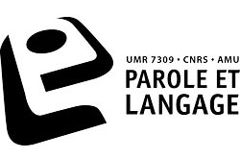Mercredi 29 Octobre 2025
Soutenance de thèse de
Kübra Bodur
Sous la direction de Christine MEUNIER (amU) et Corinne FREDOUILLE (Avignon Université)
Précédée de conférences de Richard Ogden et Barbara Schuppler
En salle de conférences B011 au LPL, Aix-en-Provence
Evènement ouvert à tout le monde
Programme :
10h Conférences de Richard Ogden (University of York) : Phonetic features in the interactional management of laughter
& Barbara Schuppler (TU Graz) : Distribution and timing of verbal backchannels in conversational speech
14h Soutenance de Kübra Bodur (LPL-amU) : Speech Reduction in Conversation: Phonetic and Discursive Abilities
Jury :
Richard OGDEN - Rapporteur (Univ. of York)
Christelle DODANE - Rapporteure (Univ. Sorbonne Nouvelle)
Barbara SCHUPPLER - Examinatrice (Technical Univ. of Graz)
Cédric GENDROT - Examinateur (Univ. Sorbonne Nouvelle)
Noël NGUYEN - Président du jury (Aix-Marseille Univ.)
Christine MEUNIER - Directrice de thèse (Aix-Marseille Univ.)
Corinne FREDOUILLE - Co-directrice de thèse (Avignon Univ.)
Résumé de la thèse FR :
La réduction de la parole est un phénomène courant du langage parlé, qui se manifeste par l’omission, la compression ou l’affaiblissement de segments. Longtemps considérée comme un phénomène purement phonétique, elle est ici redéfinie comme un processus multidimensionnel, façonné par la réalisation phonétique, l’organisation prosodique, la représentation lexicale et la planification de la parole.
Une distinction est établie entre les réductions lexicalisées, fréquentes et stables, probablement stockées dans le lexique mental, et les réductions non-lexicalisées, plus variables, dépendantes du contexte et émergentes de manière dynamique dans la production. Quatre études empiriques montrent que les réductions lexicalisées reflètent des schémas d’usage robustes, tandis que les réductions non-lexicalisées sont fortement conditionnées par le débit articulatoire, les frontières prosodiques et les catégories morphosyntaxiques. Les données développementales révèlent en outre que seuls les adultes produisent des réductions non-lexicalisées, suggérant qu’elles requièrent des compétences linguistiques et motrices avancées.
Les résultats soutiennent l’idée que la réduction constitue un continuum de comportements linguistiques, étroitement lié à la structure et au développement du langage. En intégrant des perspectives issues de la phonétique, de la prosodie et de la recherche développementale, ce travail propose un modèle unifié de la production de la parole, dans lequel la réduction offre une clé essentielle pour comprendre comment le langage est planifié, réalisé et acquis.
Résumé de la thèse EN :
Speech reduction is a common phenomenon in spoken language, manifested through omission, compression, or weakening of segments. Once regarded as a purely phonetic phenomenon, it is redefined here as a multidimensional process, shaped by phonetic realization, prosodic organization, lexical representation, and speech planning.
A distinction is drawn between lexicalized reductions, frequent and stable, likely stored in the mental lexicon, and non-lexicalized reductions, more variable, context-dependent, and dynamically emerging in production. Four empirical studies show that lexicalized reductions reflect robust usage patterns, whereas non-lexicalized reductions are strongly conditioned by speech rate, prosodic boundaries, and morphosyntactic categories. Developmental data further reveal that only adults produce non-lexicalized reductions, suggesting that they require advanced linguistic and motor skills.
The findings support the view that reduction forms a continuum of linguistic behaviors, closely tied to language structure and development. By integrating perspectives from phonetics, prosody, and developmental research, this work advances a unified model of speech production, where reduction serves as a key to understanding how language is planned, realized, and acquired.
Résumé de la conférence de Richard Ogden :
We investigate the phonetic and social organisation of laughter in conversation, expanding on Jefferson, Sacks, and Schegloff's (1987) view of laughter as a structured, co-produced event. We argue that variable phonetic details (Bachorowski et al., 2001) are crucial for participants to predict laughter completion and synchronise their own laughter. Using Conversation Analysis and phonetic analysis of English, Spanish, and Finnish conversations, we examine how participants use the phonetic details of laughter bouts as resources to manage laughter in real-time.
Most current phonetic, psycho- and neurolinguistic studies of laughter focus on aggregates of instances of laughter. This paper will focus on the processes by which participants parse laughter as it unfolds in time. I will argue that at least some of the phonetic design of laughter needs to be explained in its local context, rather than as generic functions, such as how well participants know each other. At least some features of laughter are used to manage a bout of laughter; to display alignment and affiliation; and a participant can adjust the features of their laughter to the laughter or talk of another.
We propose a four-phase schema (Chafe, 2007) to describe laughter episodes: the initiating pulse, variable exhalation sequence, glottal reset, and inhalation. The analysis details how participants utilise the phonetic affordances of each phase of laughter to signal the onset and project the termination of laughter, and to coordinate with each other and surrounding talk. For instance, an initiating pulse can signal a laughable moment, prompting others to join, while the exhalation sequence facilitates alignment through matched phonetic features.
By demonstrating how participants orient to these phonetic phases, we illustrate how the rhythmic and melodic organisation of laughter, rooted in respiration, provides the resources for coordination. This highlights the social significance of detailed phonetic features in joint laughter and contributes to a more nuanced understanding of the role of laughter in managing social interaction.
Résumé de la conférence de Barbara Schuppler :
This talk examines how verbal backchannels contribute to managing turn-taking and grounding in spontaneous conversation. Whereas previous studies have mainly focused on analyzing acoustic cues and listener behavior separately, we investigate when backchannels occur by jointly considering the prosodic characteristics and communicative functions of the preceding speech of the interlocutor. Using a corpus of spontaneous dyadic conversations annotated with continuous turn-taking labels, we show that both turn-taking function and prosody significantly influence the occurrence and timing of backchannels. This talk will then discuss initial results on modeling backchannel timing for human–robot interaction with an approach using gained insights from the corpus study.








